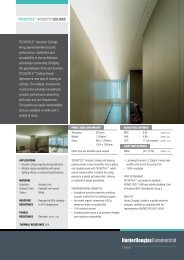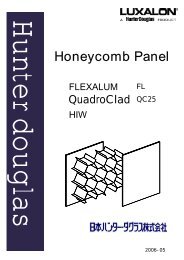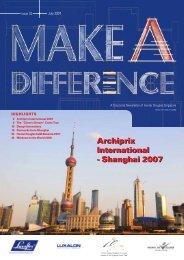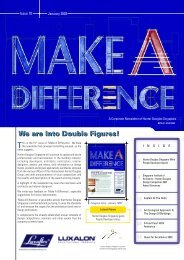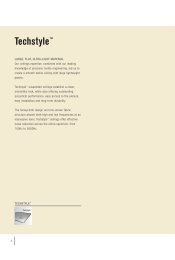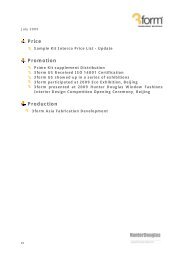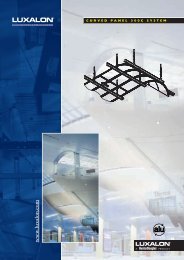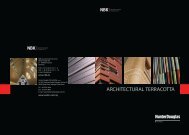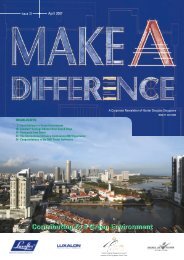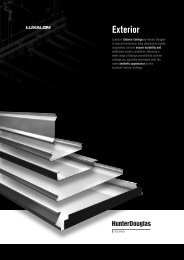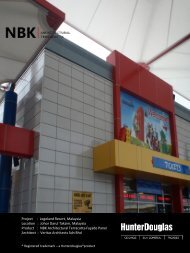Hunter Douglas hosts 4,000 at first-ever International Alliance ...
Hunter Douglas hosts 4,000 at first-ever International Alliance ...
Hunter Douglas hosts 4,000 at first-ever International Alliance ...
Create successful ePaper yourself
Turn your PDF publications into a flip-book with our unique Google optimized e-Paper software.
Study of Luxalon ® Sun Louvres ProductsBy Lavinia LimLUXALON is a p<strong>at</strong>ented trademark of <strong>Hunter</strong> <strong>Douglas</strong>. The producttype under the LUXALON trademark is architectural products, rangingfrom interior products such as ceiling and cladding panels, to exteriorproducts such as louvres and exterior cladding. This study focuseson LUXALON Sun Louvres and the product types taken into analysisare:• 84R Sun Louvre• SL 70S – 132S Aluminium Sun Louvres• Aerofoils 200AF – 450AF• Aerobrise Sun Louvres Systems (Single/Double)This study is an explor<strong>at</strong>ion of the Sun Louvres products, with theaim of charting out the extent of daylighting potential of thesesystems and its usefulness in reality.The applic<strong>at</strong>ion of sun control systems in Singapore is concernedlargely with the shading capabilities of the product. Littleconsider<strong>at</strong>ion is given to the daylighting capabilities of the shadingsystem and the notion of balancing shading and n<strong>at</strong>ural daylighting.In the new light of environmental sustainability, designers are lookingout for products with gre<strong>at</strong>er energy saving value and n<strong>at</strong>uraldaylighting is one energy saving method to tap into. Sun controlsystems hold the potential in providing n<strong>at</strong>ural daylightingpossibilities. They need not merely be shading systems but they cando a dual function of shading and allowing for daylight to enter theinterior space.Besides introducing daylight, the original function of louvres keepingout undesirable he<strong>at</strong> is still an important criteria in the choice of suncontrol products. Due to the necessity of keeping out the hotequ<strong>at</strong>orial sun in Singapore, there is a large possibility of overshadingoccurring due to a lack of concrete pre-applic<strong>at</strong>ion study and analysisof the local clim<strong>at</strong>e and its result on the use of sun control systems.Hence the following study hopes to uncover the potential of the Sunlouvres products and its effectiveness in the Singapore clim<strong>at</strong>e, basedon Ecotect analysis.Singapore’s Solar Clim<strong>at</strong>eIn order to engage product systems <strong>at</strong> their full potential, it isnecessary to <strong>first</strong> understand the local clim<strong>at</strong>e in which we are livingin. Understanding the solar clim<strong>at</strong>e aids designers in making a wellinformed decision with product choice and applic<strong>at</strong>ion.The solar clim<strong>at</strong>e in the tropics can be considered to be an extremeone with a very small range in vari<strong>at</strong>ion. The solar clim<strong>at</strong>e in Singaporeis characterised by high solar radi<strong>at</strong>ion, high sun angle and a largeamount of diffuse daylight, all of which are rel<strong>at</strong>ively uniform in valuesthroughout the year. The following will introduce the main elementsof Singapore’s solar clim<strong>at</strong>e th<strong>at</strong> gre<strong>at</strong>ly influences the use of n<strong>at</strong>uraldaylighting and also the exposure to solar radi<strong>at</strong>ion.1. Sun PositionIn order to understand where the sun rays are coming from, it isimportant to refer to a sunp<strong>at</strong>h diagram. The sunp<strong>at</strong>h is theposition of the sun th<strong>at</strong> constantly changes throughout the dayand throughout the year and a set of predicted sun positions ischarted in a sunp<strong>at</strong>h diagram as seen in Figure 2. Figure 2 showsa stereographic projection gener<strong>at</strong>ed from Ecotect, Figure 1,shows a sky dome projected onto a horizontal plane with theobserver loc<strong>at</strong>ed <strong>at</strong> the centre. Ecotect is a complete buildingdesign and environmental analysis tool th<strong>at</strong> covers the broadrange of simul<strong>at</strong>ion and analysis functions required to trulyunderstand how a building design will oper<strong>at</strong>e and perform. Thesoftware is used extensively by engineers, local authorities,environmental consultants and building designers, as well asowner-builders and environmental enthusiasts alike.Figure 1 Figure 22. Sun AngleThe sun is positioned <strong>at</strong> a high sun angle above Singapore. Thesun angle between 1<strong>000</strong> hours and 1400 hours is an average of65 o , refer to Figure 3. The sun angle is measured from thehorizontal plane to the ray of the sun when it hits the earth.The sun angle is an important factor in the applic<strong>at</strong>ion ofdaylighting systems, especially so in the use of sun shadingdevices and light reflectors as the angle becomes crucial in theeffectiveness of these systems. It can be generally said th<strong>at</strong> ahigh sun angle prevents the illumin<strong>at</strong>ion from the sun, frompenetr<strong>at</strong>ing far into a building interior, hence limiting its n<strong>at</strong>uraldaylighting capabilities, thus a need for the use of daylightredirecting devices.The high sun angles reflected in Figure 3 corresponds to theSpring Equinox (20th / 21st of March) and the Autumn Equinox(22nd / 23rd of September) and the low sun angles correspondsto the Summer Solstice (21st / 22nd of June) and the WinterSolstice (21st / 22nd of December), giving an approxim<strong>at</strong>e sunangle range between 52 o and 89 o .Figure 3 Figure 43. Sky TypeThere are 4 different sky types and they reflect the level of luminanceof the sky th<strong>at</strong> changes according to altitudes as shown in Figure 4.The sky type in Singapore is the Intern<strong>at</strong>ional Commission onIllumin<strong>at</strong>ion (CIE) Standard Overcast Sky. The Overcast Sky is acompletely clouded sky where the sun and its position are not apparent.The passage of radi<strong>at</strong>ion through the clouds usually produces close towhite light by mixing with moisture droplets. The distribution ofluminance in such a sky is symmetrical about the zenith and is lower <strong>at</strong>the horizon than overhead.The luminance <strong>at</strong> the zenith is 3 times brighter than <strong>at</strong> the horizon. Anovercast sky due to high cloud cover causes a large amount of diffuseddaylight. How<strong>ever</strong> the diffused daylight in Singapore does not lack inbrightness, cre<strong>at</strong>ing a whole sky of bright and glaring diffused light.This is unfortun<strong>at</strong>e because the redirecting of direct sunlight is largelyeasier than redirecting diffused light and large amount of bright diffusedlight results in glare, which becomes a very big issue.Figure 54. Sun DirectionThere are basically only 2 Sun directions, North-South and East-Westof which daylight will penetr<strong>at</strong>e a building. And East-West is the directionof the gre<strong>at</strong>est concern due to it being the direction of sun travel, thusit is in this axis th<strong>at</strong> a building will receive the most he<strong>at</strong> and illumin<strong>at</strong>ion.Figure 65. Solar Radi<strong>at</strong>ionThe East and West are the directions of the gre<strong>at</strong>est concern dueto it being the direction of the sun travel. Thus it is in this directionalaxis th<strong>at</strong> a building will receive the most he<strong>at</strong> and illumin<strong>at</strong>ion. Aresearch done by Universiti Teknologi Malaysia (UTM), to analysethe amount of direct and diffuse incident solar radi<strong>at</strong>ion andtransmitted solar he<strong>at</strong> gain through a glass window, revealed th<strong>at</strong>the total amount of solar radi<strong>at</strong>ion received on the east windowwas higher than th<strong>at</strong> of the other orient<strong>at</strong>ions, <strong>at</strong> 370.3kW/m 2 .High solar radi<strong>at</strong>ion is expected in the equ<strong>at</strong>orial region due to itsclose proximity to the sun. The diurnal temper<strong>at</strong>ure vari<strong>at</strong>ion is small,from 31 o C to 33 o C during the day. The existence of such a largeamount of constant radi<strong>at</strong>ion infers th<strong>at</strong> insul<strong>at</strong>ion from he<strong>at</strong> gainon a building façade is an important consider<strong>at</strong>ion. The lack of solarinsul<strong>at</strong>ion will result in the he<strong>at</strong>ing up of the interior space, leadingto a higher and more costly cooling load. Therefore, sun shadingdevices or sun deterring devices are essential in the tropical clim<strong>at</strong>e.The 4 louvred systems were compared based on the following criteria:1. Daylight LevelDaylight level is the amount of daylight th<strong>at</strong> is allowed into theinterior. A high daylight level is ideal, for it results in savings inartificial lighting and other tangible benefits.2. Isol<strong>at</strong>ion LevelIsol<strong>at</strong>ion level reveals the amount of exposure the interior is allowedto solar radi<strong>at</strong>ion. The lower the level of isol<strong>at</strong>ion, the better becauseit prevents the interior from overhe<strong>at</strong>ing.3. Extent of View to the OutsideA view to the outside is largely preferable in an office space. Viewto the outside can be defined by the elev<strong>at</strong>ional view or a slantedview out.4. Types and AdaptabilityTypes and adaptability of a system refers to the vari<strong>at</strong>ions of aparticular system th<strong>at</strong> allows it to be customised to apply to differentconfigur<strong>at</strong>ion of spaces and different clim<strong>at</strong>e. Adaptability is alsoimportant for it determines if special provisions are required for asystem’s applic<strong>at</strong>ion or can a system be integr<strong>at</strong>ed or beindependent of the building structure.5. Flexibility of BladeThe flexibility of blade refers to the blade’s ability for adjustment,be it manually or motorised. The ability to adjust the angle andorient<strong>at</strong>ion of the blade goes to aid the louvred system’s ability toblock out direct sunlight.6. Light Guiding PossibilityAnd last of all, the light guiding possibility is the opportunity of onelouvred system to be converted into a light redirecting device, whichgoes to improve the n<strong>at</strong>ural daylighting in a space.About LaviniaArchitecture to me is a means of humanistic design, tocre<strong>at</strong>e sustainable buildings th<strong>at</strong> embrace n<strong>at</strong>ure andspaces th<strong>at</strong> elev<strong>at</strong>e the human experiences. My designinclin<strong>at</strong>ion is in the designing of parts to cre<strong>at</strong>e the whole, through themanipul<strong>at</strong>ion of details and m<strong>at</strong>erials, resulting in a product, whichcombines both the idea and function, allowing for a gre<strong>at</strong>er humanisticappreci<strong>at</strong>ion of space.1819



